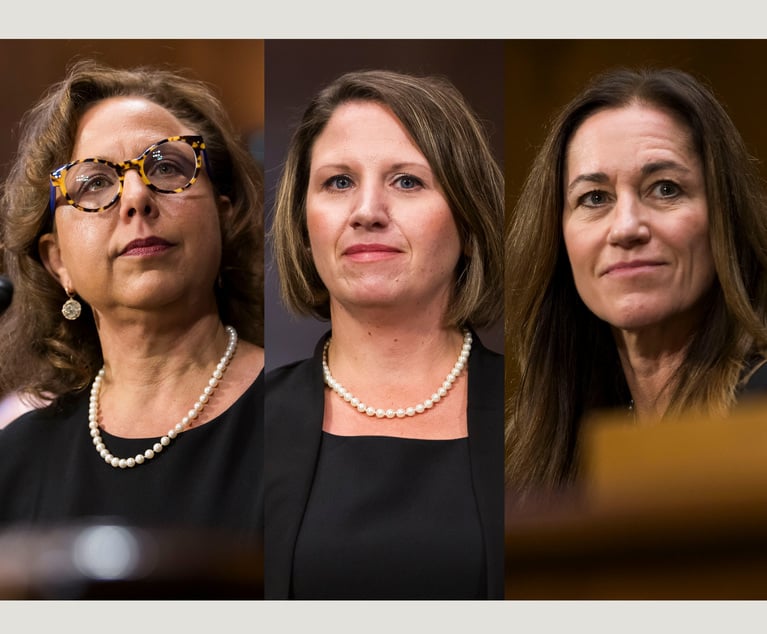As OT Rule Changes, Construction Employers Should Examine Job Descriptions
As of the new year, an estimated 1.2 million more salaried employees in "white-collar" positions will become eligible for overtime pay, completing an effort to update federal regulations that had not changed in 15 years.
November 07, 2019 at 01:16 PM
7 minute read
 Elaina Smiley(left) and Joshua Lorenz(right) of Meyer, Unkovic & Scott.
Elaina Smiley(left) and Joshua Lorenz(right) of Meyer, Unkovic & Scott.
As of the new year, an estimated 1.2 million more salaried employees in "white-collar" positions will become eligible for overtime pay, completing an effort to update federal regulations that had not changed in 15 years.
This should not be unfamiliar for employers, as a previous attempt to change the salary threshold to exempt certain employees from overtime requirements was derailed by the courts in 2016. Despite that setback and a new White House administration, a change to how the Department of Labor (DOL) mandates who can receive overtime pay was inevitable.
When we think of the industries that will be most affected by this new rule, the focus may go to the health care or finance industries, which are flooded with employees in lower-level administrative roles. The impact will be widespread, however, and businesses in all sectors should be prepared, including construction.
With more fluid job descriptions and employee roles at companies, the construction industry has more employees who will become overtime-eligible than employers may realize. With only weeks left before the new regulations take effect on Jan. 1, 2020, construction professionals who have yet to address the change have no time to spare—and those who think they are in the clear may not be.
What Does the Rule Change?
Under the Fair Labor Standards Act, employers must pay workers time and a half for hours worked in excess of 40 hours in a work week. Currently—but not for much longer—employees performing executive, administrative or professional duties and paid more than $455 per week ($23,660 annually) are exempt from overtime requirements.
With the current threshold established in 2004, there was nearly universal public demand that it be increased. In 2016, the Obama administration's DOL attempted to double it and mandate automatic adjustments, but the rule was found unlawful in a federal court.
The new rule sets the threshold in between the current one and the 2016 rule, raising the "standard salary level" to $684 per week ($35,568 annually). Accordingly, anyone making below that amount —even if the employee is performing duties that fall into "white-collar" categories—will be eligible for overtime.
The final rule also includes a provision that allows employers to use nondiscretionary bonuses and incentive payments (including commissions) that are paid at least annually to account for up to 10% of the standard salary level.
What Duties Trigger Exemptions?
Before the 2016 rule was struck down, many employers reached out looking to reassess their policies, job descriptions and duties, making sure they knew which employees would be eligible for overtime. Notably, a common misconception that existed then unfortunately is still prevalent today: Many employers believe so long as an employee receives a salary (as opposed to being paid on an hourly basis), that employee is exempt from overtime pay. This is incorrect, though. The exemption is only applicable when an employee meets both the salary threshold and has primary duties that meet the requirements.
The DOL has helpful fact sheets that break down the specifics of what qualifies as executive, administrative and professional duties, though it's the first two categories that will apply most to exempt positions found in the construction industry.
A brief overview:
- Executive duties: The employee primarily manages the enterprise or a customarily recognized department of the enterprise; the employee customarily and regularly directs the work of at least two or more other full-time employees.
- Administrative duties: The employee primarily is concerned with the performance of the office or nonmanual work directly related to management or general business operations and the employee's primary duty includes the exercise of discretion and independent judgment with respect to matters of significance.
How Do Job Duties Affect the Construction Industry?
Often when companies take an in-depth look at the actual job duties employees are performing, they discover that employees have been misclassified. This is especially common within construction firms, as one employee can wear many hats depending on the circumstances and the project.
For example, a nominally desk-bound employee may actually spend significant amounts of time managing a few employees in the field and performing manual work. Sometimes, too, a worker's duties evolve without anyone taking note of it in an official capacity. Perhaps the employee takes on the nonexempt duties of a coworker on leave, or maybe the employee underperforms in one role and moves into another requiring different skills and responsibilities. Any time an employee's duties evolve, it can change whether that employee is eligible for overtime pay—even if that employee's official job description or salary would appear to say otherwise.
Job descriptions are not only important to determine overtime eligibility. It is essential that someone's actual duties match his job description when it comes to accuracy in administrative processes and proceedings, such as disability and workers' compensation claims or doctors' fitness for duty releases.
How Can Companies Adapt to the Rule?
As mentioned above, the proposed rule change of 2016 spurred many employers to take a fresh look at their operations and prepare for new overtime requirements. This time around, there does not seem to be the same sense of urgency. It could be that the new rule is flying under the radar, that employers are not paying attention, or that they may think they are compliant with the new overtime rules after reassessing a few years ago.
However, much can happen in a short period of time—new employees may arrive, current employees may take on different roles and business practices may change. Managers and human resources personnel should continually be analyzing their employees' job descriptions, their salary levels and how these evolving factors may affect their overtime eligibility.
If employees are misclassified and are not properly paid overtime, they can file an administrative claim with the federal or state department of labor or file a lawsuit. At that point, a company faces paying the employee backpay and double damages. A governmental investigation is likely to result in more overtime violations being found for additional employees as well, thus compounding the impact.
When reassessing employee salaries, duties and job descriptions, in some cases, employers may find it easier and more cost-efficient to raise workers' salaries to the new salary threshold, or they may want to convert employees to an hourly rate and implement policies to limit excessive overtime. This is where a time-tracking system can be useful.
Connecting with a legal expert will be the best step for a company to make sure it is ready for the new overtime rule. From the reaction, or lack thereof, from employers this time around, it is possible there are many who need to review their policies, job descriptions and employees' overtime eligibility to avoid potentially large legal liabilities for employees who are misclassified.
Elaina Smiley is an attorney with Pittsburgh-based law firm Meyer, Unkovic & Scott. She focuses her practice on employment and immigration law. Contact her at [email protected].
Joshua Lorenz, an attorney at the firm, focuses his practice on construction and real estate law and litigation. Contact him at [email protected].
This content has been archived. It is available through our partners, LexisNexis® and Bloomberg Law.
To view this content, please continue to their sites.
Not a Lexis Subscriber?
Subscribe Now
Not a Bloomberg Law Subscriber?
Subscribe Now
NOT FOR REPRINT
© 2025 ALM Global, LLC, All Rights Reserved. Request academic re-use from www.copyright.com. All other uses, submit a request to [email protected]. For more information visit Asset & Logo Licensing.
You Might Like
View All
Pa. Federal District Courts Reach Full Complement Following Latest Confirmation

The Defense Bar Is Feeling the Strain: Busy Med Mal Trial Schedules Might Be Phila.'s 'New Normal'
7 minute read
Federal Judge Allows Elderly Woman's Consumer Protection Suit to Proceed Against Citizens Bank
5 minute read
Judge Leaves Statute of Limitations Question in Injury Crash Suit for a Jury
4 minute readTrending Stories
- 1Settlement Allows Spouses of U.S. Citizens to Reopen Removal Proceedings
- 2CFPB Resolves Flurry of Enforcement Actions in Biden's Final Week
- 3Judge Orders SoCal Edison to Preserve Evidence Relating to Los Angeles Wildfires
- 4Legal Community Luminaries Honored at New York State Bar Association’s Annual Meeting
- 5The Week in Data Jan. 21: A Look at Legal Industry Trends by the Numbers
Who Got The Work
J. Brugh Lower of Gibbons has entered an appearance for industrial equipment supplier Devco Corporation in a pending trademark infringement lawsuit. The suit, accusing the defendant of selling knock-off Graco products, was filed Dec. 18 in New Jersey District Court by Rivkin Radler on behalf of Graco Inc. and Graco Minnesota. The case, assigned to U.S. District Judge Zahid N. Quraishi, is 3:24-cv-11294, Graco Inc. et al v. Devco Corporation.
Who Got The Work
Rebecca Maller-Stein and Kent A. Yalowitz of Arnold & Porter Kaye Scholer have entered their appearances for Hanaco Venture Capital and its executives, Lior Prosor and David Frankel, in a pending securities lawsuit. The action, filed on Dec. 24 in New York Southern District Court by Zell, Aron & Co. on behalf of Goldeneye Advisors, accuses the defendants of negligently and fraudulently managing the plaintiff's $1 million investment. The case, assigned to U.S. District Judge Vernon S. Broderick, is 1:24-cv-09918, Goldeneye Advisors, LLC v. Hanaco Venture Capital, Ltd. et al.
Who Got The Work
Attorneys from A&O Shearman has stepped in as defense counsel for Toronto-Dominion Bank and other defendants in a pending securities class action. The suit, filed Dec. 11 in New York Southern District Court by Bleichmar Fonti & Auld, accuses the defendants of concealing the bank's 'pervasive' deficiencies in regards to its compliance with the Bank Secrecy Act and the quality of its anti-money laundering controls. The case, assigned to U.S. District Judge Arun Subramanian, is 1:24-cv-09445, Gonzalez v. The Toronto-Dominion Bank et al.
Who Got The Work
Crown Castle International, a Pennsylvania company providing shared communications infrastructure, has turned to Luke D. Wolf of Gordon Rees Scully Mansukhani to fend off a pending breach-of-contract lawsuit. The court action, filed Nov. 25 in Michigan Eastern District Court by Hooper Hathaway PC on behalf of The Town Residences LLC, accuses Crown Castle of failing to transfer approximately $30,000 in utility payments from T-Mobile in breach of a roof-top lease and assignment agreement. The case, assigned to U.S. District Judge Susan K. Declercq, is 2:24-cv-13131, The Town Residences LLC v. T-Mobile US, Inc. et al.
Who Got The Work
Wilfred P. Coronato and Daniel M. Schwartz of McCarter & English have stepped in as defense counsel to Electrolux Home Products Inc. in a pending product liability lawsuit. The court action, filed Nov. 26 in New York Eastern District Court by Poulos Lopiccolo PC and Nagel Rice LLP on behalf of David Stern, alleges that the defendant's refrigerators’ drawers and shelving repeatedly break and fall apart within months after purchase. The case, assigned to U.S. District Judge Joan M. Azrack, is 2:24-cv-08204, Stern v. Electrolux Home Products, Inc.
Featured Firms
Law Offices of Gary Martin Hays & Associates, P.C.
(470) 294-1674
Law Offices of Mark E. Salomone
(857) 444-6468
Smith & Hassler
(713) 739-1250





